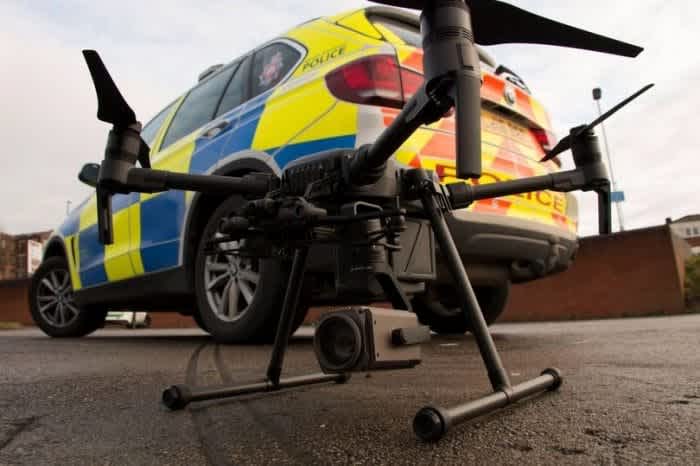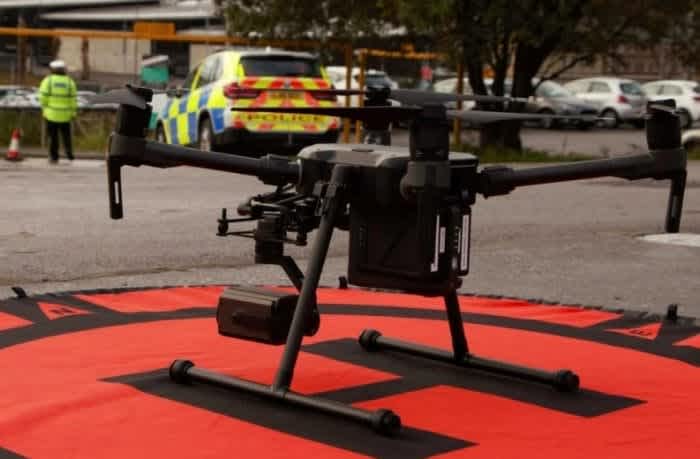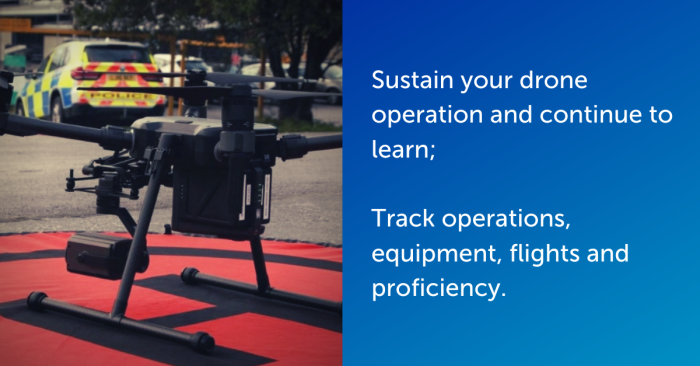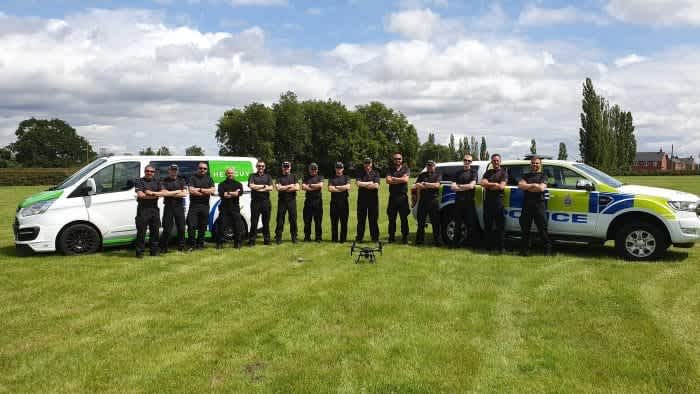
Updated on 17 Sep 2024
10 Tips For Building A Public Safety Drone Programme
Industry advice on how to build a drone programme for the emergency services and how DJI Gold Partner Heliguy can start, support or scale your operations. ... Read More

A guide to building a drone programme for public safety operations;
Tips include starting small, networking and learning from others, being vocal about your programme, and planning ahead for scaling up;
DJI Gold Partner Heliguy supports more than 40 of the UK's emergency services and we can help you start your drone programme thanks to our vast stock pool, bespoke public safety training, and in-house technical team;
Drones are key for public safety operations, providing vital situational awareness, helping to shape tactics and enhancing crew safety.
Finding missing people, providing vital situational awareness, and improving crew safety - drones have become a key tool for public safety and law enforcement.
These eyes in the sky provide incident commanders with immediate and detailed intelligence and boost team communication, which helps to shape informed and efficient deployments and enhances crew safety during missions.

So it is no surprise that police drones are credited with saving more than 300 lives, and adoption rates within the emergency services have 'skyrocketed' in recent years as UAS (Unmanned aircraft system) technology increasingly proves its worth.

It sounds good, and perhaps you want your organisation to get in on the act and start benefiting from drones.
But where do you start? What do you need to consider when building a drone programme and how do you overcome the challenges of setting up, integrating the technology into your existing workflows, and sustaining your operations?

Drones, like the DJI M200 Series, are a key tool for the police.
In this Heliguy Insider blog post, we highlight 10 tips to establishing a successful public safety UAS division, based on key insights from Romeo Durscher, DJI's Senior Director of Public Safety Integration, and Alfonso Zamarro, who is Drones Activities Manager at EENA (European Emergency Number Association) - a non-governmental organisation with the mission to contribute to improving the safety and security of people.
If you start following some of these tips, your process might go smoother than if you didn't do your homework or didn't follow our tips.
Romeo Durscher, DJI'S Senior director of public safety integration
If you are encouraged to start a drone programme, DJI Gold Partner Heliguy is perfectly placed to help you. As a European enterprise award-winner and with access to a vast stock pool of drones and payloads, we support more than 40 of the UK's public safety organisations. We also offer specific and bespoke training for the emergency services. This post will explore how we can start or scale your public safety drone operations.
10 Tips For Starting Your Drone Programme
Tip 1: Don't Reinvent The Wheel

The first tip is that you don't need to reinvent the wheel. Look to others who have already established a drone programme and learn from them.
Alfonso said: "Five years ago, talking about drones in emergency services was a rare thing and very new. Now, it is pretty normal to talk about drones for first responders.

"There is a lot of people with a lot of experience out there and I think connecting with the right people, especially in your own country or region, and learning from the early mistakes they made, can save you a lot of time and money."
Romeo agreed. He said: "What I have learned is that everyone is open and willing to share knowledge and experiences, such as lessons learned, standard operating procedures, guidelines, and training scenarios, as well as advice on hardware and software. So don't go and do everything on your own - get the larger community involved and learn from them."
Tip 2: Smart Small

"This is my favourite tip," admitted Alfonso, as he encouraged departments who are establishing a drone programme to start small and build around a specific use case.
But it seems that not everyone heeds this advice.
Romeo said: "I always see that when a department is about to start a drone programme, there are big visions and many ideas of how drones can be used. And yes, that is all true, but our recommendation is to start small. Focus on potentially one use case, master that use case, and then grow.
"I also encourage teams to train on small platforms, learn how they operate and work and then scale up."

Starting small can help you grow your drone programme in the long run.
He added that, sometimes, attempts to start a drone programme can be met with reluctance or scepticism from top bosses who don't understand the technology and what it can do.
Romeo believes that starting small can help to win round the powers that be.
He said: "We had a department that was experiencing exactly this, so they decided to start indoor operations. This was approved for law enforcement and for the first six months they only utilised drones indoors, but they got some really good wins and put together a good package to show what they were achieving and asked to add to this and use drones for outdoor operations.
"So it was like building blocks. Start small and build on top of each other. That is a good approach."

The DJI Mavic 2 Enterprise can be used for a range of public safety operations.
Starting small also ensures that your investment in drone technology is not wasted down the line, according to Alfonso.
He said: "This is about agile deployment and agile innovation. So, don't start with having the perfect final solution or the fanciest drones with all of the accessories, or start suddenly with a large team, because the risk of that is that you create something that doesn't really adapt to your needs and then the drone ends up not really being used.
"So, start small. Find the use case first and test it out in different environments and find the one that's most relevant for your case. Improve, become an expert, and understand what you actually need and then show this to the decisionmakers."
Tip 3: Involve Your Organisation And Community

The third tip is to be open about your drone programme and let the public know what you want to achieve.
Romeo said: "Be transparent and involve your organisation. I think this one gets a little bit overlooked.
"My experience has been that, if somebody starts a drone programme in an organisation, this person is the most passionate about it and might be flying drones as a hobby and wants to bring this into the department and make it something for work.

Be vocal about your drone programme, especially to reassure the public.
"Along the way, you have to get your buy-in from your management or leadership team, and then you have also got to showcase the technology to the community and show what it can do and what it can't do.
"The public might have concerns about a drone programme, especially privacy issues when it comes to law enforcement. It is very important that you are vocal about what you will do and what you won't do."
Alfonso added: "If you want to set up a sustainable drone unit you will need political and economic support for that, meaning that the people at the top need to know why it is relevant and why it will contribute to making your service even greater.

"It is also important to show incident commanders what the drone can and can't do and what the limits and advantages are of this capability.
"You can even go beyond your own organisation because other emergency services who are operating in your area could actually benefit from this.
"One good example of this is Mid and West Wales Fire Department. They started using drones and they started to interact with the police department and now they are usually called by the police department to help them on search and rescue operations.
"They got permission to fly with helicopters and also at night and this is because everyone - decision-makers and public safety organisations - understood the benefits of this technology and wanted to integrate it.

A drone with a thermal camera can be a key tool for the emergency services, especially when it comes to fighting fires.
"Think out of the box. It is important that you share that drones can help with situational awareness, which in turn helps with the safety of crews and safety of staff and this is 100% aligned with what the unions are trying to achieve."
Tip 4: Test, Train, And Learn

Practice makes perfect. It sounds cliche, but when it comes to developing a drone programme, this saying really is true.
Romeo said: "This one is fun, it is important, but it is also a challenge. Test, train and learn about your equipment, from the hardware and the software side, and put together good documentation which helps to share this knowledge to operators who might join the team."

This was demonstrated during the Drone Efficacy Study, which evaluated how drones could impact search and rescue operations and reduce the time it takes to find a missing civilian or casualty.
Alfonso said: "When it came to the time it took to locate a casualty, there was a big difference between junior teams who were new to the technology and those who had been using drones for quite some time.
"The point is, you should invest time in learning how to use the platform and you should also document it and make this advice scalable, which shortens learning and deployment times."

When it comes to search and rescue, drones can cut the time it takes to
Heliguy runs specialist and tailor-made ES-DOT courses for the emergency services. Keep reading this blog to find out more.
Tip 5: Understand Rules and Regulations

Romeo said: You have got to know your local regulation off by heart and prepare for it. It is your responsibility as the drone lead to familiarise yourself with all of this, but it is also an opportunity for organisations like ENNA to come in and help."
For more on UK drone laws, rules and regulations, click here.
Tip 6: Integration

Integration. It's a keyword when it comes to establishing a drone programme and it should be a leading consideration.
Romeo said: "There are two major things here. The first is how do you integrate the hardware into your existing deployment model and then how do you integrate all of the data that you gather so it becomes a helpful tool to incident commanders at the scene, but also later on, for example for collision reconstruction.

Ensure your team knows how drones and drone data will be integrated into your operations.
"It also means that incident commanders have to learn what drone data is available and how to read and utilise the data to their advantage."
Alfonso added that the type of data you want to collect will shape your operations, so careful consideration is needed before deployment.
He said: "The first question is what sort of data am I generating, who will consume that data and for what purpose and in what format. That will condition everything.

Drone data can provide useful insights.
"In some cases, you will need to stream information and in some other cases, you don't. The whole process changes depending on what you decide to do."
Tip 7: Geo Unlocks

DJI enterprise drones can be unlocked through DJI’s Qualified Entities Programme (QEP), which allows public safety personnel to conduct drone operations without restriction.
Through the QEP, DJI will remove all domestic geofencing limitations and altitude limitations for enterprise aircraft.
This will allow users to fly in sensitive locations and at higher altitudes, to enable critical operations such as disaster response, firefighting, search and rescue, and other public-safety applications.

Emergency services are encouraged to take advantage of the QEP.
Romeo encouraged public safety organisations to take advantage of this.
He said: "Our drones have GPS built-in and we can geofence drones to tell them that they are not supposed to fly into a certain area, like an airport or a critical infrastructure facility.
"However, public safety teams might need to fly in these areas, so we have created the QEP geo-unlock process for public safety organisations. This is an important thing if you're in public safety."
The DJI enterprise platforms which can be unlocked are the Matrice 200 Series (V1 and V2), Mavic 2 Enterprise, Phantom 4 RTK and Matrice 600 Pro.
To apply for the QEP, click here.
Tip 8: Standardise Operations

Standardising operations, working in collaboration with other crews, and perfecting a joint response can greatly increase the effectiveness of a drone mission.
This was a key topic at the recent International Disaster Response Conference, in London, where Romeo discussed the drone-deployment strategies at three wildfires in California in 2017 and 2018, and how these operations improved as time went on.

A scene from one of the California wildfires, as captured by a drone.
He said: "One of biggest lessons learnt was that if we all come together and talk together and train with each other and we create regional teams, we start to standardise ourselves and when we deploy together things will go so much smoother.
"There was a tremendous difference in the drone response between the first and last wildfire, only because in between these incidents we didn't just go home and do nothing.
"The various departments, including fire and law enforcement, kept meeting once a quarter, talking about deployment strategy, issues they had come across, they trained together, and established proper communications with each other and it really helped along the way.

Various public safety teams came together to bolster operations.
"It is one of the biggest tips that I can give. See if there's a group or groups in your area or region who might be meeting with each other. If not, take the initiative and start a regional training group. There is a tremendous benefit in doing so."
Tip 9: Continue To Network

Learn, learn, and learn some more. Even after you have started your programme, continue to share your experiences and pick up advice from others.
Romeo said: "Go and network. Not only with other public safety agencies but join teams or organisations like ENNA and others that consist of people who want to advance not only the technology but also the use cases. It is so helpful.

DJI's Romeo Durscher.
"Go to conferences where you meet like-minded people who potentially have the same issues as you. By talking to each other you might come up with solutions. This is a big point."
Alfonso added: "We are all learning and sharing, so it is a great opportunity. ENAA is free to join for first responders. Network and connect with people."
Tip 10: Scale Up

So, you've started your drone programme, and it has been a success. Now it's time to scale up and expand your division. However, a key piece of advice is that you need to begin thinking about how you will grow sooner rather than later.
Romeo said: "If you do everything right, you will see the success and you will get to the point where you have to scale up. It is fascinating to see that, up until the end of 2018, the big question was 'how do I start a drone programme?' But in 2019, we started to get the question, 'how do I scale up?'

Heliguy has helped Derbyshire Constabulary train and expand its drone team.
"Today, we are seeing departments who have 30 to 150 drones. A scaling-up process brings additional challenges - you have to maintain a larger team, and also track training, flights, operations and equipment, and there are different software solutions out there. You have to test these to find out what suits you and your needs.
"But you also have to think ahead for scaling up, not just at the time when you get the funding or you get the go-ahead to increase your team. You have to have a plan in place."
How Can Heliguy Support Your Drone Programme?
DJI Gold Partner and European enterprise award-winner Heliguy has a track record of supplying and supporting public safety drone programmes, with more than 40 of the UK's emergency services on our books.
With access to a huge inventory of stock, Heliguy can dynamically and quickly equip teams with the latest drones and sensors - either offering them for purchase or rental.
Our vast stock pool includes the DJI M200 Series and its associated payloads, such as the Z30 zoom camera and XT2 thermal sensor; and the Mavic 2 Enterprise series, which includes the Mavic 2 Enterprise Dual with thermal capabilities. The Mavic 2 Enterprise series can also be integrated with three accessories - a loudspeaker, beacon and spotlight, which are ideal for public safety and search and rescue missions.


Away from DJI, we offer other options including Elistair's tethering system, ideal for long surveillance or security missions; the Teradek live-streaming backpack; and ViewPro's range of cameras, as well as the Wingsland Z15 Bright Spotlight.
Meanwhile, our expert training team runs dedicated ES-DOT (Emergency Services Drone Operators Training) courses, specifically designed to provide comprehensive yet succinct vocational training for the police, as well as other public-safety organisations such as the Fire and Rescue Service, Mountain Rescue and the Coastguard.

Heliguy's Head of Training Ben Shirley delivering a course for the police.
The sessions can be adapted to suit the requirements of the organisation, from a condensed theoretical course to a more comprehensive programme with progressive and practical flight training and assessment. Candidates benefit from one-to-one flight training with our experienced instructors to build competence and confidence with the procedures for their aircraft.
An additional air law module is offered to ensure our candidates are fully prepared to use the CAA Exemption for Emergency Services (E4506) and its practical application.

Candidates will gain valuable exposure to the considerations and procedures that must be used to ensure safety when operating their aircraft in a manner that is outside the normal operating limits.
Heliguy has trained personnel from numerous public safety organisations, including the police forces of Derbyshire, Cumbria, Lincolnshire Police and North Wales Police.

Organisations can take advantage of this equipment and expertise through Heliguy's rental programme, which allows you to rent the latest technology without large upfront costs and ensures you are not left with redundant or old equipment.
To find out how Heliguy can start, support or scale your drone programme, give us a call or send us an email. Heliguy is open 8am to 6pm, Monday to Thursday, and 9am to 5pm on a Friday.

written by
James Willoughby
James joined heliguy™ in 2018 following a 13-year stint in print and online journalism, having worked on regional and weekly newspaper titles. He is responsible for spearheading heliguy™'s content strategy and social media delivery. James collaborates with DJI Enterprise's European marketing team to coordinate and produce case studies and helps organise events and webinars.